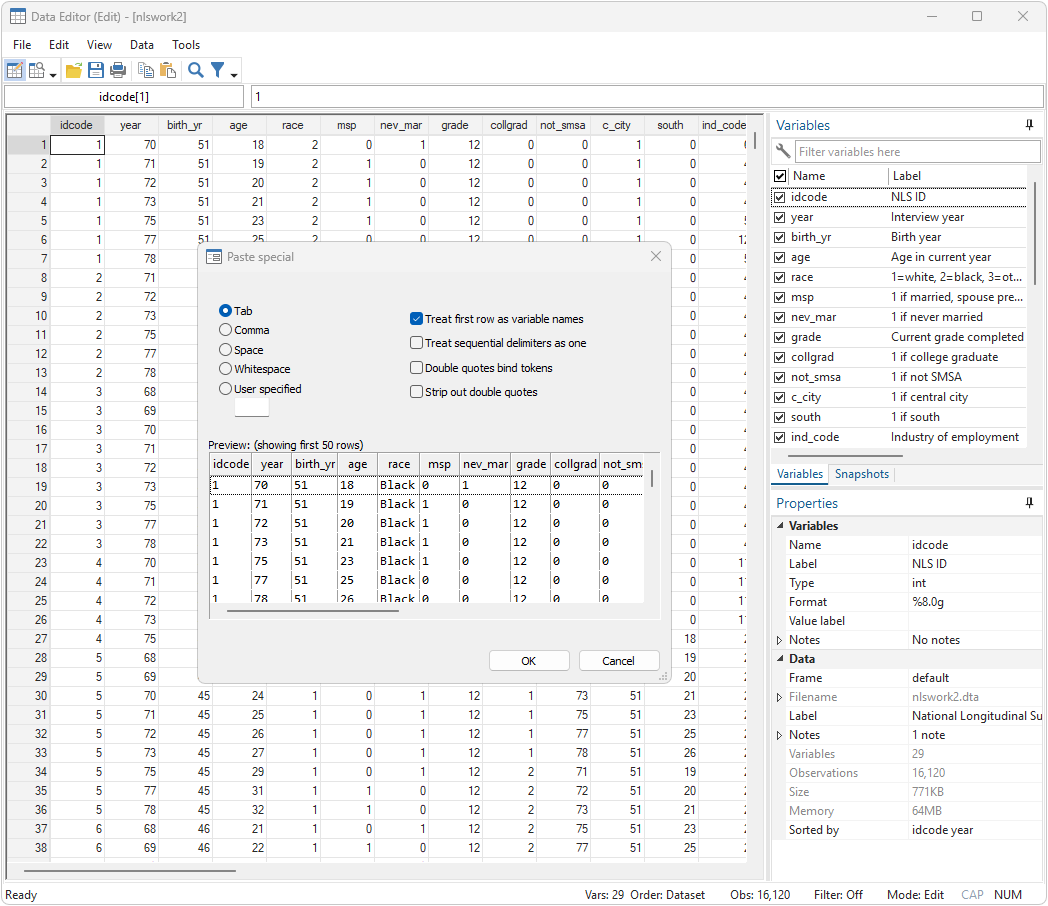Stata for Students is focused on the latter and is intended for students taking classes that use Stata. Those who plan on doing research with Stata should read the more rigorous introduction found in Stata for Researchers. Stata for Students has two parts: Using Stata and Basic Statistics, Regression and Graphs. STATA Software License. We offer STATA 15 SE for staff, faculty, and students at UCR. The license type is an annual license, renewed September 30th. Graduate and undergraduate students paid through the Student Technology Fee. Stata software, free download laptop. Development Tools downloads - Stata 11 by StataCorp LP and many more programs are available for instant and free download. Colgate offers several software options for students at Colgate, whether in public labs or for free download and install on your personally owned equipment. AWS Appstream 2.0 is the recommended method for access to Colgate licensed windows software such as Matlab, R, Maple, Stata, SPSS, ArcGIS,.
A Visual Guide to Stata Graphics, Third Edition by Whether you are new to Stata graphics or a seasoned veteran, A Visual Guide to Stata Graphics, Third Editionwill reach you how to use Stata to make publication-quality graphics that will stand out and enhance your statistical results. With over 900 illustrated examples and quick-reference tabs, this book quickly guides you to the information you need for creating and customizing high-quality graphs for any type of statistical data. Each graph is displayed in full color with simple and clear instructions that illustrate how to create and customize graphs using either Stata commands or the Stata Graph Editor. Stata's powerful graphics system gives you complete control over how the elements of your graph look, from marker symbols to lines, from legends to captions and titles, from axis labels to grid lines, and more. Whether you use this book as a learning tool or a quick reference, you will have the power of Stata graphics at your fingertips. The third edition has been updated and expanded to reflect new Stat graphics features, and includes many additional examples. This updated edition illustrates new features to specify fonts and symbols. New sections have been added that illustrate the use of the marginsplotcommand as well as the use of contour plots.| Original author(s) | William Gould[1] |
|---|---|
| Developer(s) | StataCorp |
| Initial release | 1985 |
| Stable release | |
| Written in | C |
| Operating system | Windows, macOS, Linux |
| Type | Statistical analysis |
| License | Proprietary |
| Website | www.stata.com |
Stata is a general-purpose statistical software package created in 1985 by StataCorp. Most of its users work in research, especially in the fields of economics, sociology, political science, biomedicine, and epidemiology.[2]
Stata's capabilities include data management, statistical analysis, graphics, simulations, regression, and custom programming. It also has a system to disseminate user-written programs that lets it grow continuously.
The name Stata is a syllabic abbreviation of the words statistics and data.[3] The FAQ for the official forum of Stata insists that the correct English pronunciation of Stata 'must remain a mystery'; any of 'Stay-ta', 'Sta-ta' or 'Stah-ta' (rhymes of the three pronunciations of 'data') are considered acceptable. More recent updates indicate that Stata employees pronounce it /ˈsteɪtə/. [3]
There are four major builds of each version of Stata:[4]
- Stata/MP for multiprocessor computers (including dual-core and multicore processors)
- Stata/SE for large databases
- Stata/IC, which is the standard version
- Numerics by Stata, supports any of the data sizes listed above in an embedded environment
Small Stata, which was the smaller, student version for educational purchase only, is no longer available.
User interface[edit]
Stata has always emphasized a command-line interface, which facilitates replicable analyses. Starting with version 8.0, however, Stata has included a graphical user interface based on Qt framework which uses menus and dialog boxes to give access to nearly all built-in commands. This generates code which is always displayed, easing the transition to the command line interface and more flexible scripting language. The dataset can be viewed or edited in spreadsheet format. From version 11 on, other commands can be executed while the data browser or editor is opened.
Data structure and storage[edit]
Until the release of version 16[5], Stata could only open a single dataset at any one time. Stata holds datasets in (random-access or virtual) memory, which limits its use with extremely large datasets. This is mitigated to some extent by efficient internal storage, as there are integer storage types which occupy only one or two bytes rather than four, and single-precision (4 bytes) rather than double-precision (8 bytes) is the default for floating-point numbers.
The dataset is always rectangular in format, that is, all variables hold the same number of observations (in more mathematical terms, all vectors have the same length, although some entries may be missing values).
Data format compatibility[edit]
Stata can import data in a variety of formats. This includes ASCII data formats (such as CSV or databank formats) and spreadsheet formats (including various Excel formats).
Stata's proprietary file formats have changed over time, although not every Stata release includes a new dataset format. Every version of Stata can read all older dataset formats, and can write both the current and most recent previous dataset format, using the saveold command.[6] Thus, the current Stata release can always open datasets that were created with older versions, but older versions cannot read newer format datasets.
Stata can read and write SAS XPORT format datasets natively, using the fdause and fdasave commands.
Some other econometric applications, including gretl, can directly import Stata file formats.

Extensibility[edit]
Stata allows user-written commands, distributed as so-called ado-files, to be straightforwardly downloaded from the internet which are then indistinguishable to the user from the built-in commands. In this respect, Stata combines the extensibility more often associated with open-source packages with features usually associated with commercial packages such as software verification, technical support and professional documentation. Some user-written commands have later been adopted by StataCorp to become part of a subsequent official release after appropriate checking, certification, and documentation.
User community[edit]
Stata had an active email list from August 1994 ('Statalist', over 1000 messages per month) which was turned into a web forum in March 2014 and is still called 'Statalist'.[3] StataCorp employees regularly contribute to Statalist. It is maintained by Marcello Pagano of the Harvard School of Public Health, and not by StataCorp itself.
Articles about the use of Stata and new user-written commands are published in the quarterly peer-reviewedStata Journal. The Stata Journal is a quarterly publication containing articles about statistics, data analysis, teaching methods, and effective use of Stata's language.
User Group meetings are held annually in the United States (the Stata Conference), the UK, Germany, and Italy, and less frequently in several other countries. Only the annual Stata Conference held in the United States is hosted by StataCorp LP. Local Stata distributors host User Group meetings in their own countries, however, Stata developers frequently travel to and present at these meetings. Established under the Societies Act on 10 May 2008, Singapore Stata Users Group is the world's first government-approved users group (Registration No: 2048/2008; Unique Entity No: T08SS0091A). Its slogan is 'Shaping Data Meaningfully'. As a non-profit organisation, StataUGS does not organise regular meetings but provides programming and statistical advice to users in Singapore through informal means. The active members of StataUGS are mostly engaged in biomedical research.

Example Stata code[edit]
To perform a linear (OLS) regression of y on x:
The optional part if allows to restrict the sample used in the command to a subset. For example, if the command should only be applied to the females in the sample, one could specify: if female 1.
To perform logistic regression of y on x:
To display a scatter plot of y against x restricted to values of x below 10:
Stata Student Version
To perform OLS regression of y on x with White's heteroscedasticity-consistent standard errors:

To calculate Akaike Information Criterion (AIC) and Bayesian Information Criterion (BIC) for regression:[7]
To code 'fizzbuzz':
Timeline of releases[edit]
Since 2000, StataCorp have released a new major release of Stata (incrementing the integer part of the version number) roughly every two years. Users must pay a fee if they wish to upgrade to the latest major release. Minor releases (incrementing the decimal part of the version number) are sometimes made available between major releases. These are available as free downloadable updates to those who have a licence for the previous major release. Dates of all releases are available on the Stata website.[8] Stata 16 was released on June 26, 2019.
Stata's versioning system is designed to give a very high degree of backward compatibility, ensuring that code written for previous releases continues to work.[9] However, users should be careful when they save or open data among different versions.
See also[edit]
References[edit]
Stata Student Pricing
- ^'Stata Journal | Article'. www.stata-journal.com.
- ^'Who uses Stata?'. Stata. Retrieved 2017-06-28.
- ^ abc'Help - Statalist'. www.statalist.org.
- ^'Which Stata is right for me?'. Stata. Retrieved 2010-04-04.
- ^'Data frames: multiple datasets in memory'. www.stata.com. Retrieved 2020-08-13.
- ^'Stata 16 help for save'. www.stata.com.
- ^'Choosing Regression Model in Stata'.
- ^'Stata | FAQ: History of Stata'. www.stata.com.
- ^'Stata 16 help for version'. www.stata.com.
Is Stata Free For Students Research
Further reading[edit]
- Bittmann, Felix (2019). Stata - A Really Short Introduction. Boston: DeGruyter Oldenbourg. ISBN978-3-11061-729-0.
- Pinzon, Enrique, ed. (2015). Thirty Years with Stata: A Retrospective. College Station, Texas: Stata Press. ISBN978-1-59718-172-3.
- Hamilton, Lawrence C. (2013). Statistics with STATA. Boston: Cengage. ISBN978-0-84006-463-9.
External links[edit]




